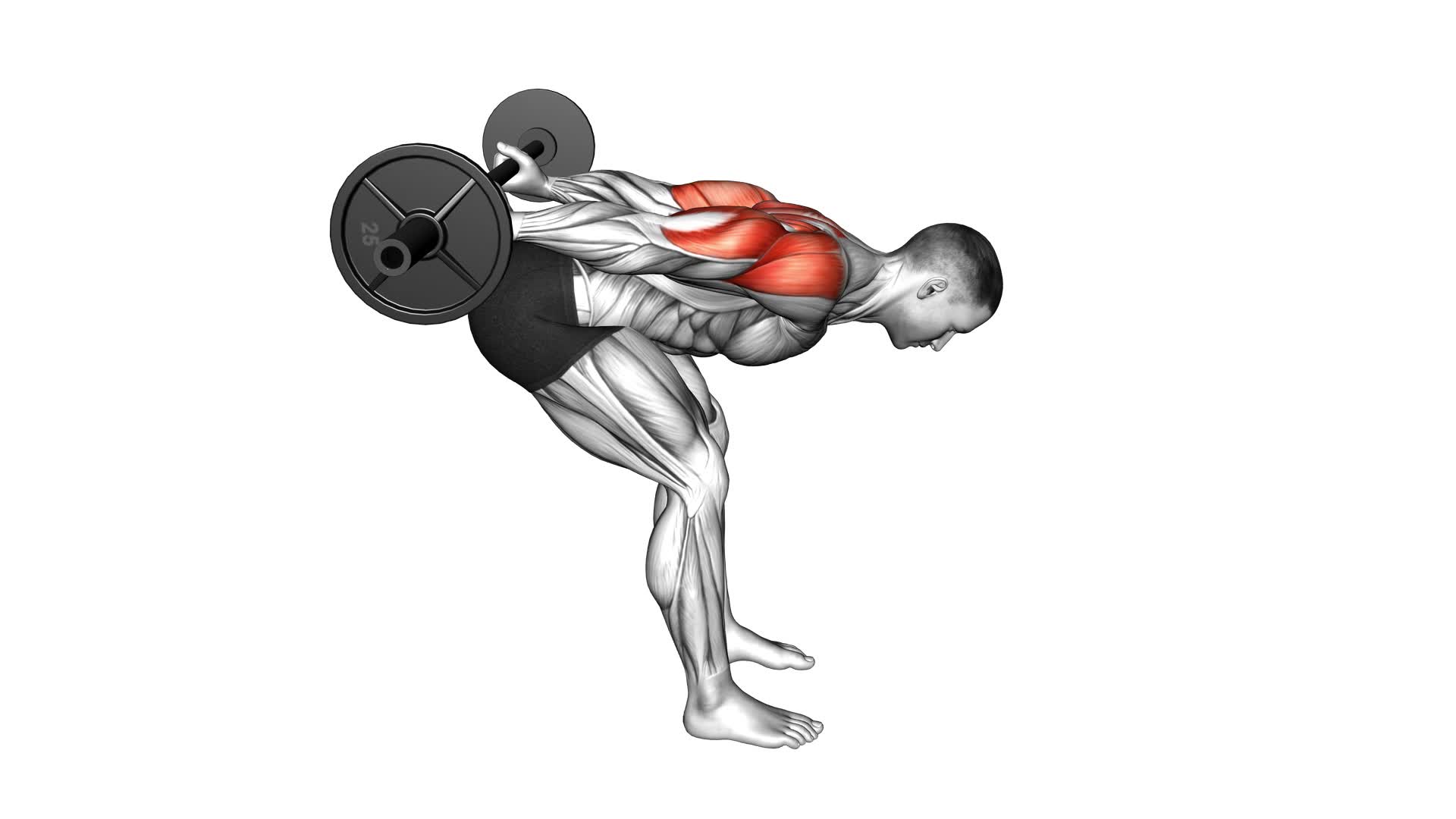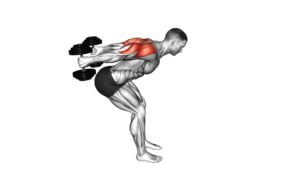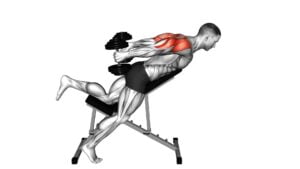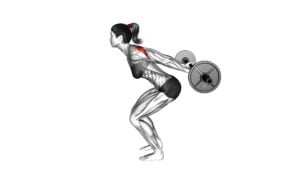Barbell Bent Over Reverse Raise (skier) (male) – Video Exercise Guide & Tips

Are you looking to strengthen your upper body and core muscles? Then the Barbell Bent Over Reverse Raise (skier) is the exercise for you!
Watch This Exercise Video
In this video exercise guide, we will show you the proper equipment and set-up, along with a step-by-step guide on how to perform this challenging exercise.
We will also cover common mistakes to avoid, tips for increasing intensity, and safety precautions.
Get ready to take your fitness to new heights with this effective exercise.
Key Takeaways
- Targets back muscles including latissimus dorsi, rhomboids, and trapezius
- Improves posture and reduces the risk of back pain or injury
- Develops upper body strength in back, shoulders, and arms
- Challenges core stability
Benefits of the Barbell Bent Over Reverse Raise (skier)
You will experience several benefits from incorporating the Barbell Bent Over Reverse Raise (skier) into your workout routine. This exercise primarily targets the muscles of your back, including the latissimus dorsi, rhomboids, and trapezius. By strengthening these muscles, you can improve your posture, enhance your athletic performance, and reduce the risk of back pain or injury.
One of the key benefits of the Barbell Bent Over Reverse Raise (skier) is its ability to develop upper body strength. As you lift the barbell in a reverse motion, you engage and activate the muscles in your back, shoulders, and arms. This exercise also challenges your core stability, as you have to maintain a steady, bent-over position throughout the movement. Additionally, the Barbell Bent Over Reverse Raise (skier) can help improve your grip strength, which is crucial for other exercises such as deadlifts or pull-ups.
Furthermore, the Barbell Bent Over Reverse Raise (skier) offers variations to target different muscle groups and add variety to your routine. For instance, you can perform the exercise with a wide grip to focus more on your lats, or with a close grip to target your rhomboids and trapezius. You can also adjust the weight of the barbell to increase or decrease the intensity of the exercise.
Proper Equipment and Set-up for the Exercise
To properly set up for the Barbell Bent Over Reverse Raise (skier), gather the necessary equipment and position yourself in a stable and secure manner. This exercise requires a barbell and weight plates. Choose a weight that challenges you but allows you to maintain proper form throughout the movement.
Start by standing with your feet shoulder-width apart and the barbell on the ground in front of you. Bend your knees slightly and hinge at the hips to reach down and grip the barbell with an overhand grip, hands slightly wider than shoulder-width apart. Keep your back straight and core engaged as you lift the barbell off the ground and bring it up to hip level. Stand tall and step back, maintaining a slight bend in your knees. Your feet should be positioned hip-width apart. This is your starting position.
When performing the Barbell Bent Over Reverse Raise (skier), it's important to use proper form techniques to maximize the effectiveness and safety of the exercise. Keep your back straight and avoid rounding your shoulders. Engage your core muscles to stabilize your spine. Throughout the movement, maintain a slow and controlled pace, focusing on the contraction of your back muscles. Avoid using momentum to swing the weight up or down, as this can increase the risk of injury. Instead, focus on using your back muscles to lift the weight.
Safety precautions should also be taken when performing this exercise. Make sure that the area around you is clear of any obstacles to prevent tripping or hitting something. Use collars on the barbell to secure the weight plates in place and prevent them from sliding off during the exercise. If you're new to this exercise or have any underlying health conditions, it's advisable to consult with a fitness professional before attempting it. Listen to your body and stop the exercise immediately if you experience any pain or discomfort. Always prioritize safety and proper form to avoid injury and achieve the best results.
Step-by-Step Guide on Performing the Barbell Bent Over Reverse Raise (skier)
To begin, let's discuss the benefits of the Barbell Bent Over Reverse Raise (skier) exercise.
This movement primarily targets the posterior deltoids, upper back, and traps, helping to improve overall shoulder stability and strength.
Next, we'll cover the proper form techniques for executing this exercise correctly, including the recommended grip width, body position, and range of motion.
Benefits of Exercise
The efficacy of incorporating the Barbell Bent Over Reverse Raise (skier) into your exercise routine lies in its ability to enhance muscular strength and stability. By regularly performing this exercise, you can experience a wide range of physical and mental benefits, making it a valuable addition to your daily routine.
Here are some key benefits of incorporating this exercise:
- Increased muscular strength: The Barbell Bent Over Reverse Raise targets multiple muscle groups, including the back, shoulders, and core, leading to improved overall strength.
- Enhanced stability: This exercise engages the stabilizer muscles in your body, helping to improve balance and coordination.
- Postural improvement: By strengthening the muscles of the upper back, the Barbell Bent Over Reverse Raise can help correct posture issues and alleviate upper back pain.
- Increased calorie burn: This compound exercise works multiple muscles simultaneously, leading to a higher calorie burn during and after the workout.
- Mental well-being: Regular exercise, including the Barbell Bent Over Reverse Raise, has been shown to reduce stress, improve mood, and boost overall mental well-being.
Incorporating the Barbell Bent Over Reverse Raise (skier) into your exercise routine can provide you with a wide range of physical and mental benefits. From increased muscular strength and stability to improved posture and mental well-being, this exercise is a valuable addition to your daily routine.
Proper Form Techniques
Incorporate proper form techniques to maximize the benefits of the Barbell Bent Over Reverse Raise (skier) and ensure optimal results in your exercise routine. Proper form is crucial for improving stability and increasing strength during this exercise.
To begin, stand with your feet shoulder-width apart and grasp the barbell with an overhand grip, hands slightly wider than shoulder-width apart. Bend your knees slightly and hinge forward at the hips, keeping your back straight and core engaged.
Next, lift the barbell towards your chest, leading with your elbows. As you lift, squeeze your shoulder blades together and maintain a controlled movement throughout. Lower the barbell back down slowly and repeat for the desired number of repetitions.
Variations for Beginners
As you progress in your exercise routine, a helpful variation for beginners to try is the Barbell Bent Over Reverse Raise (skier). This exercise targets the shoulders, upper back, and core muscles.
Here are some beginner modifications and common mistakes to be aware of:
- Start with a lighter weight or no weight at all to focus on proper form and prevent injury.
- Keep your back straight and your core engaged throughout the movement.
- Begin with a narrower grip on the barbell to make it easier to control and lift.
- Start with a smaller range of motion and gradually increase it as you become more comfortable and stronger.
- Avoid swinging the barbell or using momentum to lift the weight, as this can lead to improper form and potential injuries.
Common Mistakes to Avoid During the Exercise
To maximize your results and prevent injury, make sure to avoid these common mistakes while performing the barbell bent over reverse raise (skier) exercise. Proper form techniques are crucial for this exercise to target the intended muscles effectively.
One common mistake is rounding your back during the movement. This not only reduces the effectiveness of the exercise but also puts unnecessary strain on your lower back. To prevent this, engage your core muscles and maintain a neutral spine throughout the entire movement.
Another mistake to avoid is using excessive momentum. Swinging the barbell up and down won't effectively target the intended muscles and can lead to injury. Instead, focus on controlled and deliberate movements, ensuring that you're using the muscles in your shoulders and upper back to lift the weight.
Additionally, avoid lifting too heavy of a weight that compromises your form. Start with a weight that allows you to maintain proper form throughout the exercise. As you progress, gradually increase the weight while still prioritizing good form.
Tips for Increasing Intensity and Progressing With the Exercise
To increase the intensity and progress with the exercise, you can challenge yourself by gradually increasing the weight and incorporating variations into your barbell bent over reverse raise (skier) routine. Here are some tips to help you increase the weights and try advanced modifications:
- Gradually increase the weight: Start with a weight that allows you to complete the exercise with proper form. As you get stronger, gradually increase the weight to continue challenging your muscles.
- Use resistance bands: Incorporate resistance bands into your routine to add extra tension and resistance. Attach the bands to the barbell and then perform the exercise as usual. This will help target your muscles in a different way.
- Try single-leg variations: Instead of using both legs, try performing the exercise with one leg at a time. This won't only increase the intensity but also improve your stability and balance.
- Increase the range of motion: Instead of stopping at parallel, try going deeper into the movement by lowering the barbell closer to the ground. This will engage your muscles more and make the exercise more challenging.
- Experiment with tempo: Play around with the speed at which you perform the exercise. Try slowing down the movement during the eccentric (lowering) phase and speeding up during the concentric (raising) phase. This will further challenge your muscles and increase the intensity of the exercise.
Safety Precautions and Modifications for Individual Needs
To ensure safety and prevent injury during the Barbell Bent Over Reverse Raise (skier) exercise, proper form is of utmost importance. It's crucial to maintain a neutral spine throughout the movement, engaging your core and keeping your back straight.
Additionally, it's essential to adjust the exercise to accommodate any individual body limitations or restrictions, such as using lighter weights or modifying the range of motion.
Proper Form Importance
Before starting the Barbell Bent Over Reverse Raise (skier) (male) exercise, it's essential to understand the importance of proper form and take necessary safety precautions and modifications for your individual needs. Proper technique is crucial to maximize the benefits of this exercise and prevent injuries.
Here are some common form errors to avoid:
- Rounded back: Keep your spine in a neutral position throughout the movement to prevent strain on your lower back.
- Jerking motions: Control the movement and avoid using momentum to lift the barbell, as this can lead to muscle imbalances and potential injuries.
- Incorrect grip: Hold the barbell with an overhand grip, slightly wider than shoulder-width apart, to maintain stability and target the correct muscles.
- Overarching neck: Keep your neck in line with your spine to avoid unnecessary strain on your neck muscles.
- Improper breathing: Breathe out as you lift the weight and breathe in as you lower it to maintain proper core stability.
Adjusting for Body Limitations
To ensure a safe and effective workout, it's important to make necessary modifications and take safety precautions based on your individual body limitations.
When it comes to the barbell bent over reverse raise (skier) exercise, there are several ways you can adjust the technique and modify the intensity to suit your needs. If you have limited mobility in your shoulders or lower back, you can use lighter weights or resistance bands to reduce the strain on those areas.
Additionally, you can adjust the range of motion by not lowering the weights too far down if you have flexibility issues. It's crucial to listen to your body and not push beyond your limits to avoid any potential injuries.
Frequently Asked Questions
How Many Sets and Reps Should I Do for the Barbell Bent Over Reverse Raise (Skier) Exercise?
For the barbell bent over reverse raise (skier) exercise, it's important to focus on proper form and technique. Start with a weight that challenges you but allows for good form. Aim for 3-4 sets of 8-12 reps, resting for about 60-90 seconds between sets.
As you progress, you can increase the difficulty by adding more weight or performing the exercise on an unstable surface. Remember to engage your core and keep your back straight throughout the movement.
What Muscles Does the Barbell Bent Over Reverse Raise (Skier) Primarily Target?
The barbell bent over reverse raise (skier) primarily targets the muscles in your back, specifically the upper and middle fibers of your trapezius. This exercise also engages your rear deltoids, rhomboids, and erector spinae muscles.
By incorporating variations of this exercise, such as using dumbbells or resistance bands, you can further challenge and strengthen these muscle groups.
The benefits of barbell bent over reverse raise (skier) include improved posture, increased upper body strength, and enhanced shoulder stability.
Can I Do the Barbell Bent Over Reverse Raise (Skier) With Dumbbells Instead of a Barbell?
Yes, you can definitely do the barbell bent over reverse raise (skier) with dumbbells instead of a barbell. Using dumbbells as an alternative to a barbell for this exercise can provide additional benefits such as increased stability and a greater range of motion.
However, it's important to note that using a barbell may allow you to lift heavier weights, which can help in building strength and muscle mass more effectively.
Ultimately, the choice between barbell and dumbbells depends on your personal preferences and fitness goals.
Is It Okay to Use a Weightlifting Belt While Performing the Barbell Bent Over Reverse Raise (Skier)?
Using a weightlifting belt while performing the barbell bent over reverse raise (skier) can provide added stability and support to your lower back. However, it's important to note that a weightlifting belt shouldn't be used as a substitute for proper form and technique.
It's always recommended to master the exercise without a belt before incorporating one. If you're looking for alternatives to the barbell bent over reverse raise (skier), you can try using dumbbells or resistance bands for a similar movement.
Can I Incorporate the Barbell Bent Over Reverse Raise (Skier) Into My Leg Day Workout Routine?
Yes, you can definitely incorporate the barbell bent over reverse raise (skier) into your leg day workout routine.
This exercise targets your hamstrings, glutes, and lower back, making it a great addition to any leg-focused workout.
To add variation to the exercise, you can try using different foot stances or using dumbbells instead of a barbell.
Remember to maintain proper form and start with lighter weights before progressing to heavier ones.
Conclusion
In conclusion, the barbell bent over reverse raise (skier) is a highly effective exercise for targeting the muscles of the upper back, shoulders, and core.
By following the proper equipment set-up and performing the exercise with correct form, individuals can experience great benefits, such as improved posture and increased strength.
It's important to avoid common mistakes and gradually increase intensity for optimal results.
As always, ensure safety precautions are taken and modifications are made as needed for individual needs.

Author
Years ago, the spark of my life’s passion ignited in my mind the moment I stepped into the local gym for the first time. The inaugural bead of perspiration, the initial endeavor, the very first surge of endorphins, and a sense of pride that washed over me post-workout marked the beginning of my deep-seated interest in strength sports, fitness, and sports nutrition. This very curiosity blossomed rapidly into a profound fascination, propelling me to earn a Master’s degree in Physical Education from the Academy of Physical Education in Krakow, followed by a Sports Manager diploma from the Jagiellonian University. My journey of growth led me to gain more specialized qualifications, such as being a certified personal trainer with a focus on sports dietetics, a lifeguard, and an instructor for wellness and corrective gymnastics. Theoretical knowledge paired seamlessly with practical experience, reinforcing my belief that the transformation of individuals under my guidance was also a reflection of my personal growth. This belief holds true even today. Each day, I strive to push the boundaries and explore new realms. These realms gently elevate me to greater heights. The unique combination of passion for my field and the continuous quest for growth fuels my drive to break new ground.







